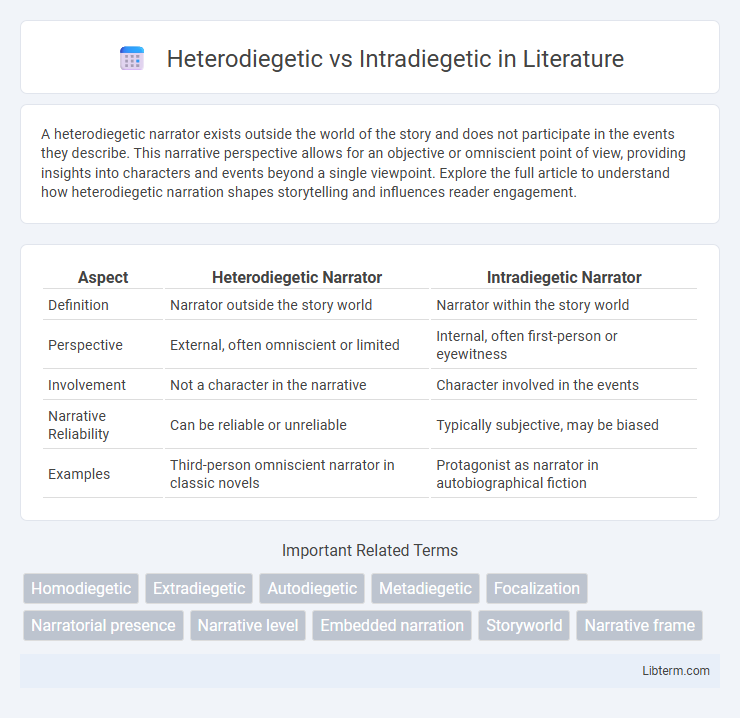A heterodiegetic narrator exists outside the world of the story and does not participate in the events they describe. This narrative perspective allows for an objective or omniscient point of view, providing insights into characters and events beyond a single viewpoint. Explore the full article to understand how heterodiegetic narration shapes storytelling and influences reader engagement.
Table of Comparison
| Aspect | Heterodiegetic Narrator | Intradiegetic Narrator |
|---|---|---|
| Definition | Narrator outside the story world | Narrator within the story world |
| Perspective | External, often omniscient or limited | Internal, often first-person or eyewitness |
| Involvement | Not a character in the narrative | Character involved in the events |
| Narrative Reliability | Can be reliable or unreliable | Typically subjective, may be biased |
| Examples | Third-person omniscient narrator in classic novels | Protagonist as narrator in autobiographical fiction |
Understanding Diegesis in Narrative Theory
Heterodiegetic narrators exist outside the story world and provide an external perspective, often offering an omniscient or limited viewpoint. Intradiegetic narrators participate within the story, conveying events from their internal perspective as characters embedded in the narrative. Understanding diegesis in narrative theory enhances comprehension of storytelling structures by distinguishing the narrative voice's relation to the story world, impacting reliability and focalization.
Defining Heterodiegetic Narration
Heterodiegetic narration occurs when the narrator exists outside the story world, providing an external perspective without participating in the events described. This narrative mode contrasts with intradiegetic narration, where the narrator is a character within the story's universe, directly involved in the plot. Understanding heterodiegetic narration is essential for analyzing narrative distance, reliability, and focalization in literary works.
Defining Intradiegetic Narration
Intradiegetic narration occurs when the narrator is a character within the story world, recounting events from their own perspective or another character's viewpoint within the narrative. This type of narration provides an insider's insight into the plot and character emotions, creating a subjective and immersive experience for the reader. In contrast, heterodiegetic narration features an external narrator who is not part of the story world, maintaining an objective and sometimes omniscient stance.
Key Differences Between Heterodiegetic and Intradiegetic
Heterodiegetic narrators exist outside the story world they describe, lacking direct involvement in the events and offering an external, often omniscient perspective. Intradiegetic narrators are characters within the narrative, recounting events from their own viewpoint, thus providing subjective insights shaped by personal experience or limited knowledge. The key difference lies in narrative participation and perspective scope, where heterodiegetic is external and all-knowing, whereas intradiegetic is internal and limited to the narrator's experience.
Narrative Perspective and Storytelling
Heterodiegetic narrators exist outside the story world and provide an external narrative perspective, often offering an omniscient or limited viewpoint that shapes how events and characters are presented to the audience. Intradiegetic narrators participate within the story world, delivering a first-person or internal narrative perspective that allows deeper access to personal thoughts, emotions, and subjective experiences. The distinction between heterodiegetic and intradiegetic narration fundamentally influences storytelling by determining narrative reliability, focalization, and the audience's engagement with plot and character development.
Examples of Heterodiegetic Narrators in Literature
Heterodiegetic narrators appear outside the story's world, telling the narrative without participating in the events, exemplified by Nick Carraway in F. Scott Fitzgerald's *The Great Gatsby*, who observes but rarely intervenes. Another key example is the omniscient narrator in Jane Austen's *Pride and Prejudice*, who provides insights into multiple characters' thoughts and events beyond any single viewpoint. These narrators offer a broader perspective, allowing readers access to overarching plot details and character developments unattainable through intradiegetic narration.
Examples of Intradiegetic Narrators in Literature
Intradiegetic narrators appear within the story world as active characters, such as Nick Carraway in F. Scott Fitzgerald's "The Great Gatsby" or Holden Caulfield in J.D. Salinger's "The Catcher in the Rye." These narrators provide a subjective perspective shaped by their involvement in the plot, allowing readers to experience the narrative through their direct observations and emotions. Their presence contrasts with heterodiegetic narrators, who exist outside the story world and narrate events without participating in them.
Impact on Reader Engagement and Interpretation
Heterodiegetic narrators, who exist outside the story world, often provide an omniscient perspective that shapes reader interpretation through broader context and thematic insights, enhancing engagement by creating a sense of authoritative distance. Intradiegetic narrators participate within the story, offering a more subjective and limited viewpoint that fosters deeper emotional connection and immersion, driving reader engagement through personal involvement. The choice between heterodiegetic and intradiegetic narration significantly influences how readers interpret character motivations and plot developments, shaping the overall narrative experience.
Selecting the Appropriate Narrative Voice
Selecting the appropriate narrative voice requires understanding heterodiegetic and intradiegetic perspectives, where heterodiegetic narrators exist outside the story world and intradiegetic narrators are characters within the story. Heterodiegetic narration offers an external, often omniscient viewpoint, ideal for comprehensive, unbiased storytelling, while intradiegetic narration provides subjective insight through a character's personal experience, enhancing emotional depth. Effective narrative voice selection aligns with the story's scope and tone, optimizing reader engagement and thematic clarity.
Heterodiegetic vs. Intradiegetic: Literary Significance
Heterodiegetic narrators exist outside the story world, providing an external perspective that enriches the thematic depth and objectivity of literary works, while intradiegetic narrators participate within the narrative, offering subjective insights and emotional immediacy. The heterodiegetic narrative voice enhances reliability and broader contextual understanding, whereas the intradiegetic perspective allows for character-driven storytelling and intimate engagement with plot events. This distinction influences narrative structure, reader alignment, and the interpretive layers of fiction, making it vital for analyzing narrative techniques and thematic complexity.
Heterodiegetic Infographic

 libterm.com
libterm.com